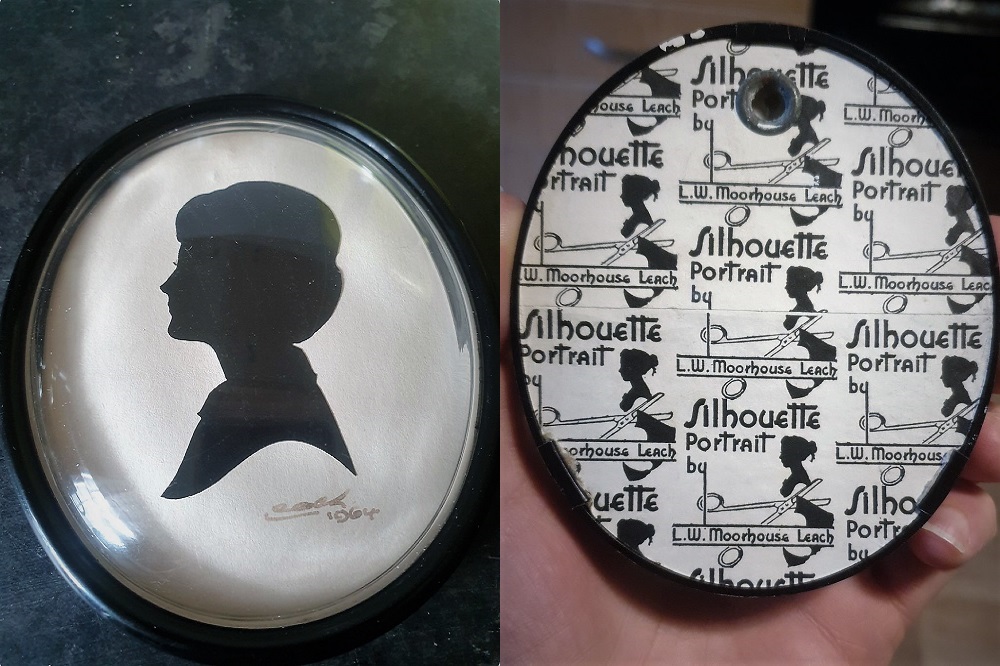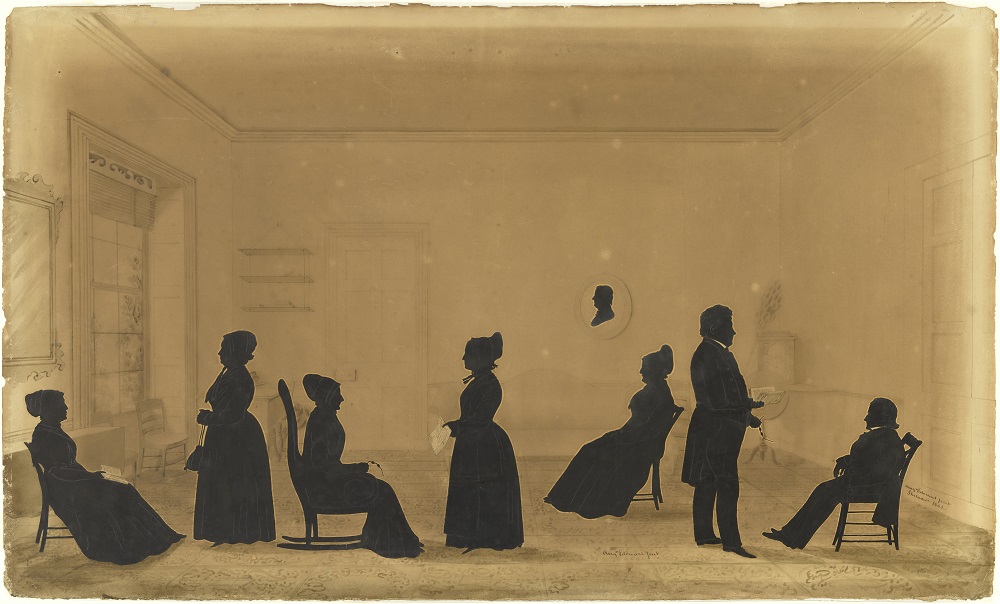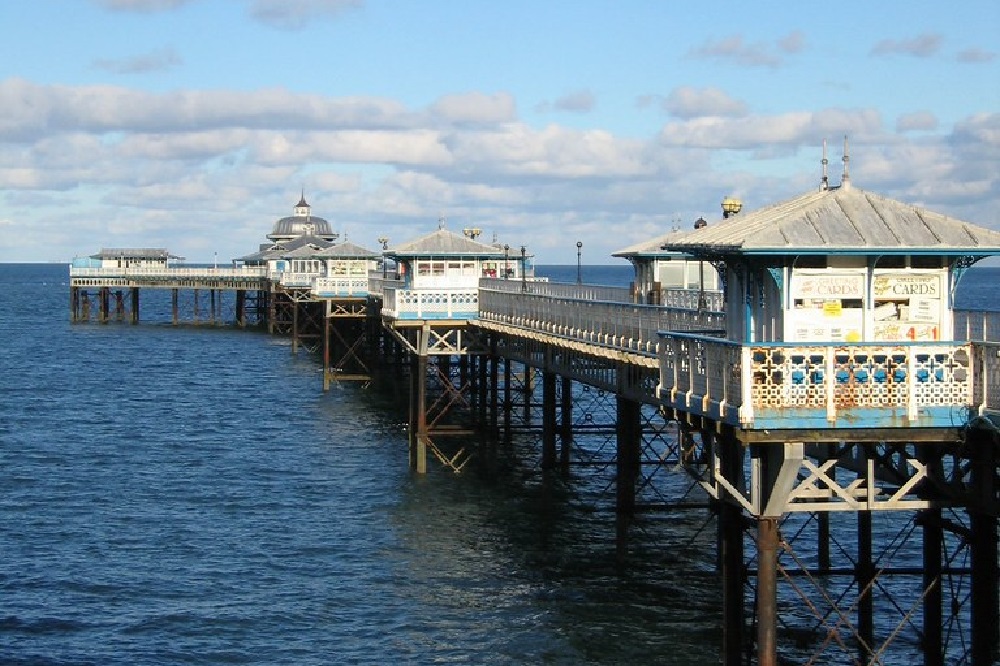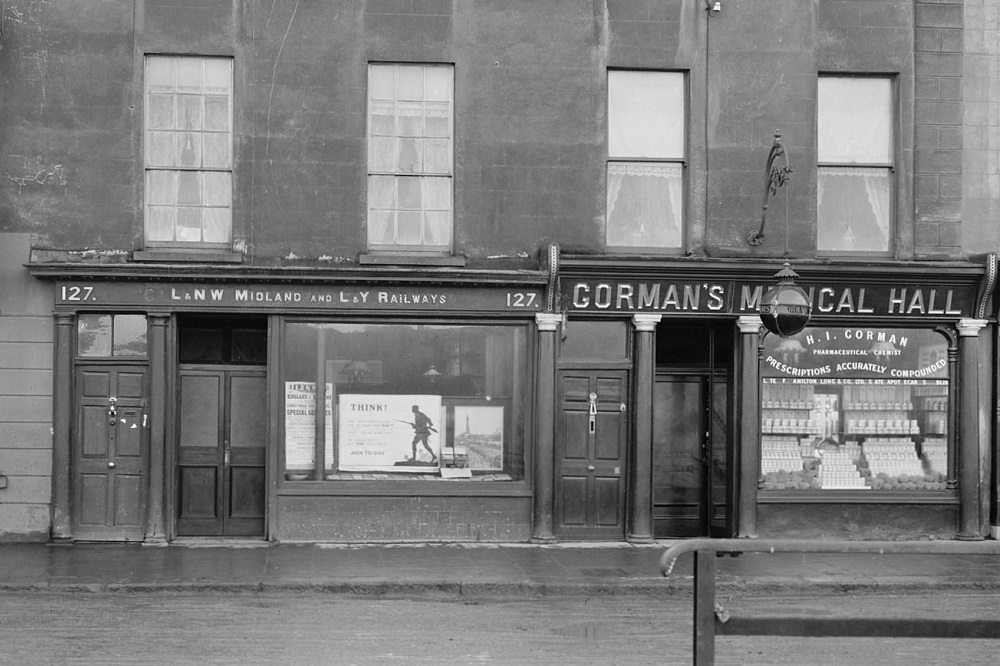Shadows from the past – sometimes it takes a Nation to solve a mystery.

Sarah Morgan Jones
House clearance warehouses can be a veritable treasure trove of curios, trinkets and oddities large and small, which can be overlooked for years on end.
Sometimes a little treasure pops up many miles from where it first began and uncovers a seldom considered moment in time.
When a little picture caught the eye of a women from Scotland and she looked into where it had come from, although she blew the dust off a little piece of Welsh history, the trail quickly ran cold.
Now this might get a little complicated so bear with me.
‘Isabel off Twitter’ (not her real name) was browsing through a local Aladdin’s cave when she came across a framed silhouette of a woman, signed by the artist, one Leslie Leach.
On the back of the frame was his business logo and his full name L.W. Moorhouse Leach, and the mini masterpiece was dated 1964.
She then did what all proper people ‘off Twitter’ do, and she shared her delightful find with the world.
It caught my eye and led to a brief text conversation and off I tumbled into the rabbit hole of silhouettes (totally justifying in my mind too much time spent scrolling).

History
Long before the advent of selfies and photo booths and in the absence of a Brownie box camera, holiday makers visiting piers around the country would perhaps create a memento of their day by having a ‘likeness’ taken in the form of a silhouette.
A skilled artist would capture a profile with swift, neat nimble scissor work and a precise eye.
Far cheaper and quicker than sitting for a portrait, the artform became popular in Georgian times, and became staple attraction of many Victorian piers lasting well into the twentieth century.
Although the Victorians were attracted to the technology of automated silhouetting using a physiognotrace, the art of freehand cutting came very much to the fore when the French artist August Edouart derided the results of a friend’s machine cut family portrait and set about proving he could do better.
Seen as the pioneer of the freehand art, Mr Edouart is also said to be responsible for introducing the word silhouette to the English language.
The magic of the freehand style became a performance in itself and as different practitioners took up the art, hundreds of thousands of these mementos appeared and still remain, varying in value according to the artist.
As the technique involved holding two pieces of paper back-to-back, many artists kept a record of their portraits, mounting the second piece in a book to form a catalogue of their work.

Mysterious Mr Leach
Turning to the internet for more information on Mr Moorhouse Leach, it seems he had been operating as a silhouettist in a kiosk (likely the centre one in the picture above) on Llandudno Pier since 1958 and at least until 1964, the date on the portrait.
Go looking much further and there seems to be dearth of information about him apart from a possible glancing mention as a possible ‘Lewis’ in the obituary of a roving geologist with the same name, who may or may not have been his son.
Following?
It’s all rather vague, although this Lewis, born in Wales and described as an outstanding artist, boarded a plane and emigrated en famille to Canada, where a career in the inland revenue awaited.
But let’s rewind to 1958.
Leslie/L.W/Lewis took over from another, very famous, artist who had been spending his summers there for decades.
Turning up year after year to spend the season snipping the snouts of strangers was a remarkable man called Harry Lawrence Oakley, who along with being a veteran and artist of the first World War, had also ‘snipped’ the likes of David Lloyd George, Clement Atlee, Aneurin Bevan and the King himself.
During the war he had been dispatched to the front to capture life in the trenches in silhouette and according to the museum in his hometown of York “Captain Harry Lawrence Oakley was one of the most talented and prolific silhouette artists of the twentieth century who created recruitment posters used not only across Britain, but in Australia, South Africa and Canada.”
Indeed, his posters “Think!” and “Remember!” quickly became iconic and ubiquitous sights.
His winters he spent in grand department stores in big cities across the UK as the hugely popular resident silhouettist, snipping hundreds of portraits a season.
But in the summer, he came to Llandudno, a place that he loved, a place where just two short years after he gave up his kiosk on the pier, his ashes were interred in the graveyard of St Tudno’s Church.

Tantalising
So back to ‘Isabel off Twitter’ and her beautiful 65p find in the Aladdin’s cave in Scotland and our man LW.
Stuttering as I was to find out more about him, I came across a ‘Professional profilist and silhouette historian’ Charles Burns, who is known for speed snipping at events, competing with the world’s fastest silhouettist, keeping a fascinating blog exploring the history of the art and a making an award winning documentary in which he meets his contemporaries, competitors and heroes.
Before coming across the full film, I found a tantalising excerpt from filming in which he meets Steve Abbott, a fellow artist and historian, on Llandudno pier on a rainy winter’s day.
In a ‘blink a few times and you miss it’ exchange, Steve mentions Moorhouse Leach as the last such practitioner on the pier, who learned his craft from Arthur Forester in Blackpool (although Arthur was a long-standing artistic occupant of Brighton Pier, from the late 1960s into the 1970s so I am not entirely sure of the Blackpool connection unless it was all part of his apprenticeship).
He then took up a residency on Rhyl pier for a few seasons before taking over from Oakley at Llandudno…and that was it.
Steve got distracted from his story in order to concentrate on the silhouette he was cutting, and my tenterhooks were left blowing in the fierce Llandudno winds.
Mystery continues
So, who was Leslie/LW/Lewis Moorhouse Leach?
Is Lewis a red herring and nothing to do with our man, or is he indeed the key to why there is no further history (that I can find in this particular rabbit hole) as he emigrated to Canada in the 1960s?
Is he the man described in his maybe-son’s obituary as the geologist’s “Welsh father Lewis” who had a wife from Yorkshire and another son called Colin?
Was he the head of the family which immigrated to Canada in the 1960s, an outstanding artist?
Is he the man of limitless energy and positivity who passed away in the early 2000s?
Conclusion needed… there will doubtless be many in Wales who have some recollection of the silhouettists of Llandudno Pier, and other piers besides.
If you can pull me out of this rabbit hole, comment below or get in touch.
Support our Nation today
For the price of a cup of coffee a month you can help us create an independent, not-for-profit, national news service for the people of Wales, by the people of Wales.





You’re right about house clearance warehouses, my local one never fails. I will make enquires as I am on the doorstep so to speak…
This was my grandads brother. Lewis William Moorhouse Leach. My grandparents had those silhouettes around the house. As I understand he lived out his days in Prestatyn
Thanks Karen that’s interesting. Any more info?
I don’t know a lot about him really as it was my mother who spoke about him. The father came from Kirtling in Cambridgeshire and worked as a post boy in Pool in Yorkshire. He took up boot making in Bradford but kept having his boots stolen! Both the boys were artistic. My grandfather went to art college in Leeds or Bradford and I was told Lewis did too. They were both quite delicate health which may be why he moved to the seaside. My great grandmother (ne Moorhouse) used to worry a lot about him. He had a family… Read more »
Lovely, thanks for that Karen.